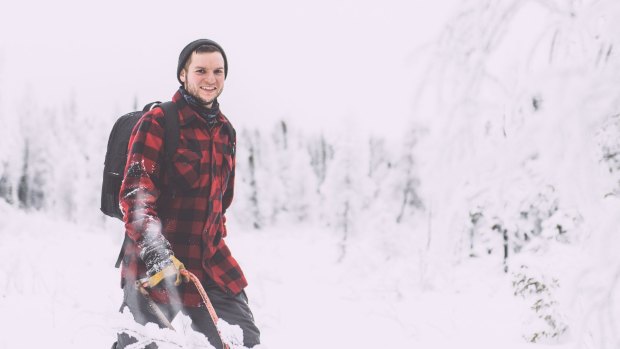This was published 5 years ago
How to stay toasty warm in sub-zero temperatures

As a guide in Canada's Northwest Territories, Kyle Thomas knows how to keep warm while enjoying the outdoors.
KYLE THOMAS
Kylie Thomas is a guide in Yellowknife in Canada's Northwest Territories, where the average January temperature is minus 26 degrees. See ykonline.ca
STEP ONE
A lot of people think they are prepared for the cold when they pull on their ski jacket. But the difference in northern Canada, Alaska or Antarctica is that it's dry, and it's a piercing cold. It's not unbearable, but minus 10 degrees with sun while you're moving isn't minus 25 degrees and pitch black, while standing in one spot.
STEP TWO
I'm a lifelong northerner, so I skip around dressed for a light fall. But visitors snowshoeing or dog sledding need winter boots rated to minus 30 degrees, with good liners and wool socks to pull moisture from the feet (often, you can rent winter gear). Jeans are tough to move around in: track pants are very common around here, or a pair of insulated snow pants with long johns, and a down-filled coat going below your waist. Mitts are always better than gloves, with smaller mitts inside, as fingers grouped together keep the residual heat. Top it all off with an insulated, double-lined or fleece-lined hat for ear protection, and sunglasses, because the sun – when it's out – is strong, and light is reflected off the snow.
STEP THREE
Camera batteries run out faster in the cold, so I do a three-battery system: one in the camera and two fully charged, kept as close to my body as possible to stay warm. Once you take your camera outside, it stays outside, even at minus 30 degrees, as condensation builds up if you're constantly bringing it in to a heated environment. Tripods are essential, especially for auroras, and I always have a flashlight handy for playing with camera settings in the dark.
STEP FOUR
When your body is cold, it's probably working harder, so you're using more energy, which means you dehydrate more quickly. Stock up on energy bars, and make sure you're drinking enough water. One trick is to put hot water in your drinking bottle in the morning, which is cool by the time you're thirsty.
STEP FIVE
In winter, polar regions get around 3½ hours of daylight, from 11am until 2.30pm. So don't plan a long lunch or to be inside in a museum – go for a hike, go dog sledding, or snowshoeing. Plan accordingly to maximise your time outdoors.
Sign up for the Traveller newsletter
The latest travel news, tips and inspiration delivered to your inbox. Sign up now.